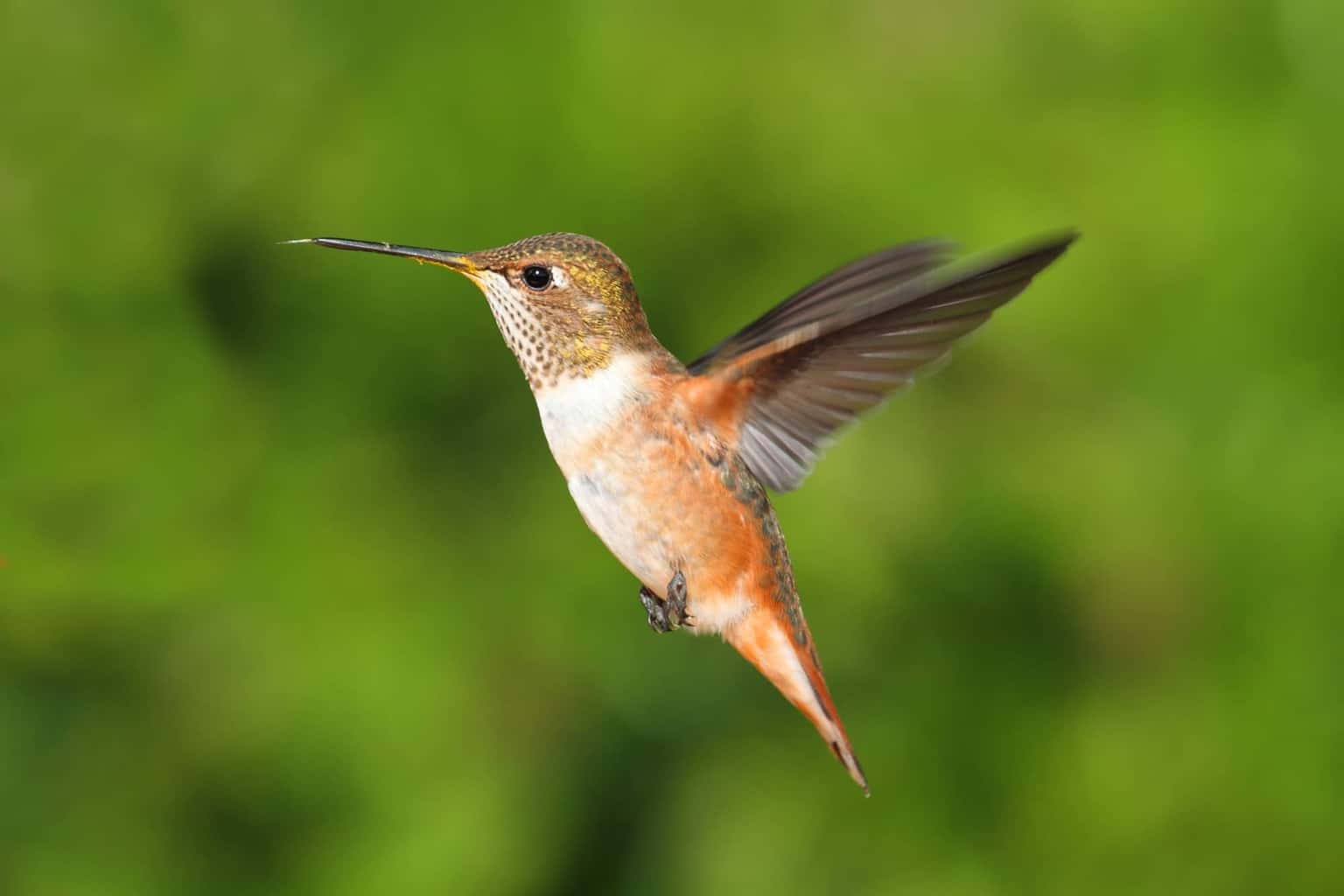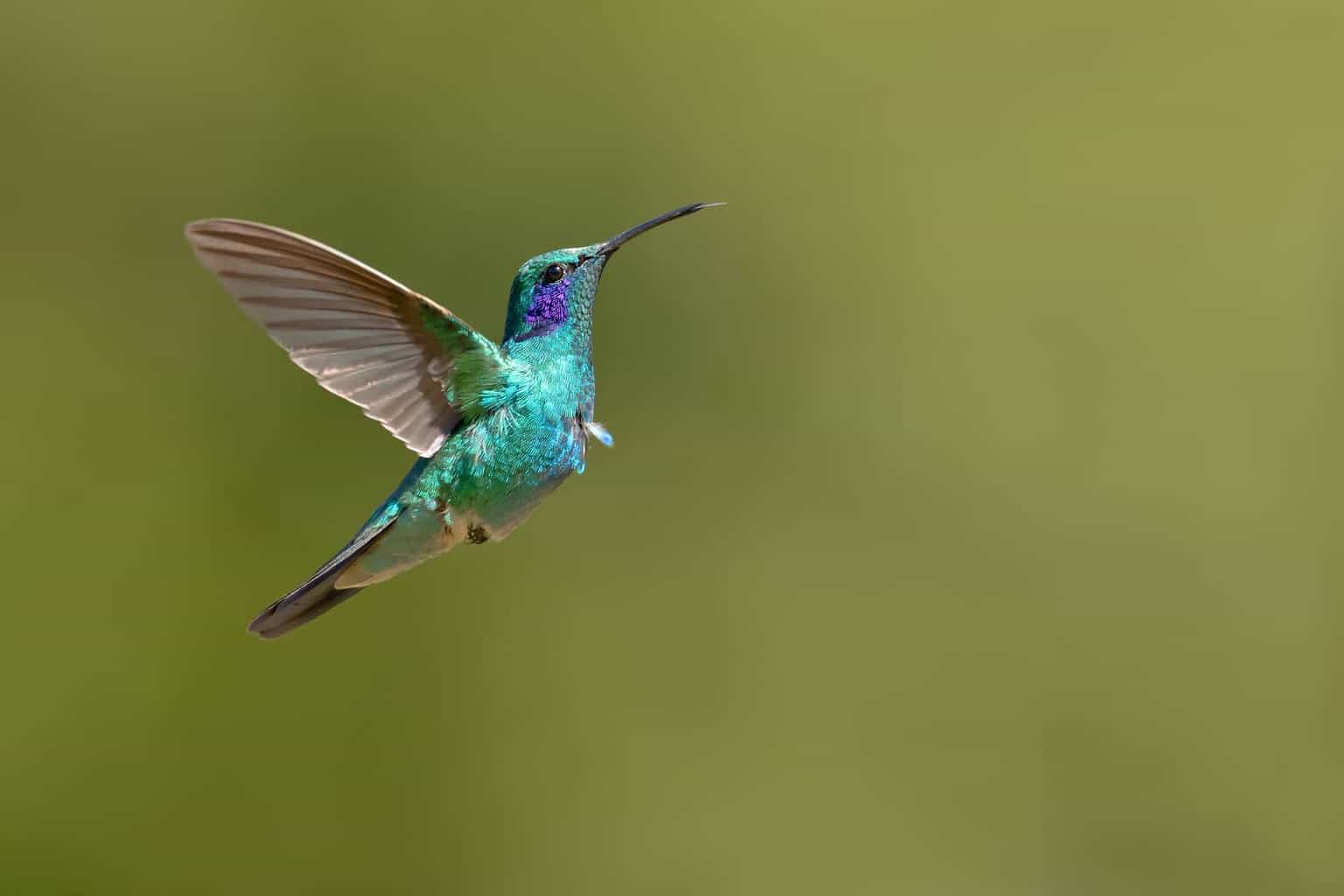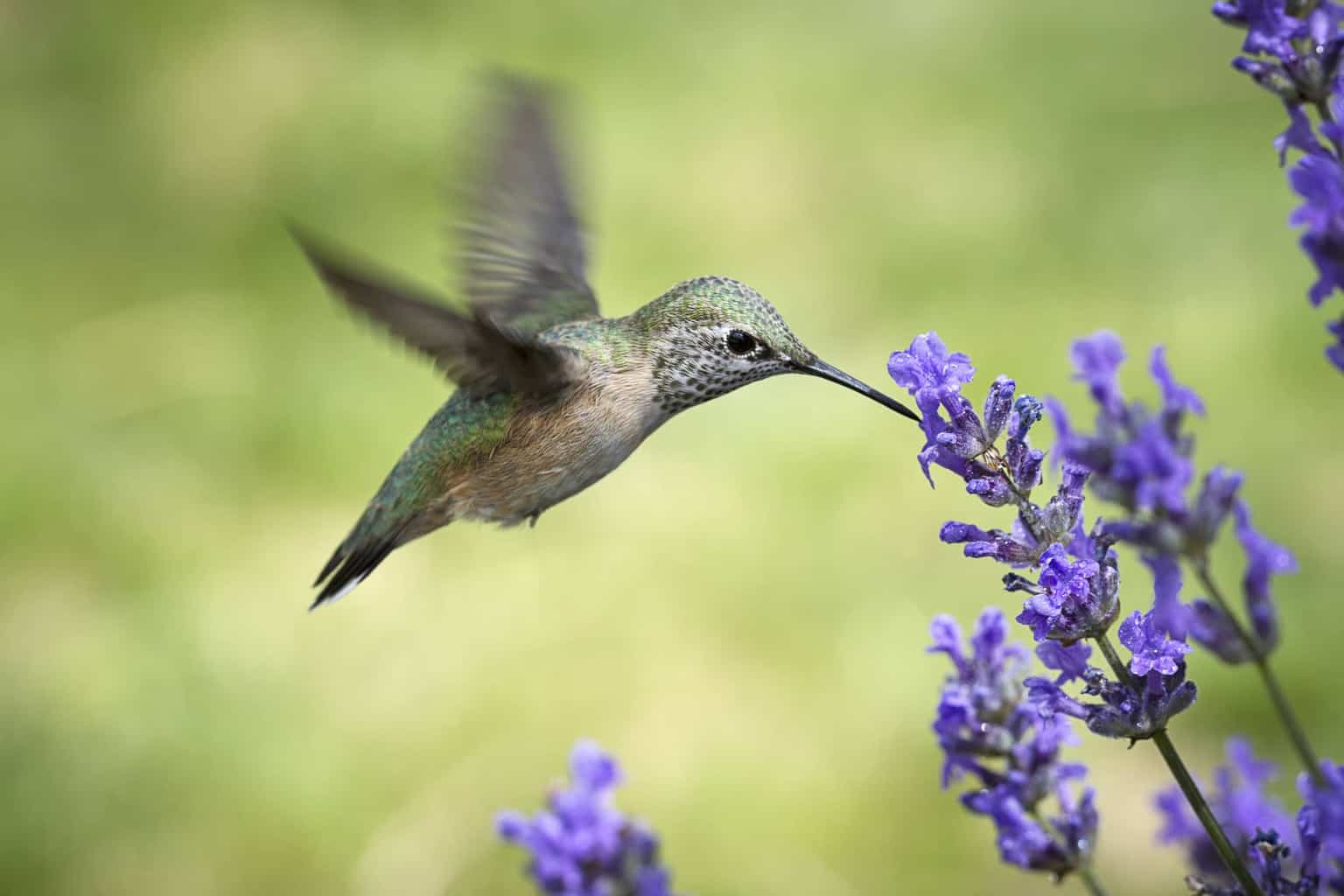The greater part of Missouri has a humid subtropical climate with cool winters and long, hot summers, whereas the northern third has a humid continental climate.
Missouri receives an average of 43 inches of rain and 13 inches of snow a year.
North of the Missouri River, which runs west to east through the state, is rolling farmland with remnant prairies, while the south of the state is home to the forested Ozark Mountains.
Missouri has a diversity of plant and animal species, including 437 bird species.
Of these species, only one hummingbird species is sometimes resident, namely, the ruby-throated hummingbird.
Three other American hummingbird species occasionally pass through Missouri: the rufous hummingbird, Anna’s and broad-tailed hummingbirds, and the Mexican violetear.
There are, however, several accident vagrants.
Identifying Missouri’s Hummingbirds
Hummingbirds fall into the family Trochilidae. This family occurs only in the Americas.
They are tiny birds and can not only hover with their wings beating so fast that they make a humming noise, but they can also fly backward – the only birds that can do so.
These beautiful birds use these abilities to sip nectar from flowers, supplementing their diet with arthropods which they catch on the wing (hawking), take from leaves, or even catch from spiderwebs.
They can burn both glucose and fructose, which other vertebrates cannot do.
We can classify the types of hummingbirds found in Missouri as Frequently Found, Seasonal Migrants, and Accidental Vagrants.
List of Hummingbirds Frequently Found In Missouri
Only one species of hummingbird is frequently found in Missouri.
Ruby-throated Hummingbirds (Archilochus colubris)

- Length: 3 — 3.5 inches
- Weight: 0.1 — 0.2 ounces
- Wingspan: 4.3 inches
Description
Ruby-throated hummingbirds have emerald green feathers on their backs, wings, and heads, with a pale gray underbelly and a forked tail.
Both the female ruby-throat hummingbird and immature birds have a white collar while mature males have the ruby-red throat that gives the species its name.
Additional Information
Ruby-throated hummingbirds occur across a large part of eastern North America in the summer breeding season.
They inhabit the margins of deciduous forest, stream banks, meadows, old fields, orchards, and gardens.
They feed on nectar from plants like red and orange tubular flowers such as trumpet creeper, native honeysuckles, and red buckeye. They supplement this source of nectar with small insects.
They arrive in early April at their summer breeding grounds and depart for their wintering grounds in Central America by the end of September. Some are resident year-round.
Male ruby-throats are a territorial hummingbird species, defending territory in the breeding grounds against other males.
List of Seasonal Migrant Hummingbirds Of Missouri
Three species of modern hummingbirds are seasonal migrants to Missouri, particularly the rufous hummingbird.
Rufous Hummingbirds (Selasphorus rufus)

- Length: 3 — 3.5 inches
- Weight: 0.1 — 0.2 ounces
- Wingspan: 3 inches
Description
Female and immature rufous hummingbirds are greenish on their backs, heads, and wings, with rusty flanks and patches on their green tails and a white breast.
Males have vivid coppery backs and bellies, an iridescent rusty-orange throat, green on their shoulders, and a white breast. The tail comes to a point when folded.
Additional Information
Rufous hummingbirds utilize forest edges, streamsides, and mountain meadows for feeding.
They breed in forest edges, clearings, and brushy second growth in the west and northwest of North America.
In July and August, they leave the western states, migrating through the Rocky Mountains to take advantage of wildflowers and establish wintering grounds in southern California, Arizona, and Mexico.
Their diets consist chiefly of native nectar-filled flowers, insects, and small spiders. They also drink sap from holes made by sapsuckers (a genus of woodpeckers).
Rufous hummingbirds are known to be pugnacious, defending a reliable nectar source against intruders, even larger hummingbirds.
Anna’s Hummingbird (Calypte anna)

- Length: 9 inches
- Weight: 0.1 — 0.2 ounces
- Wingspan: 7 inches
Description
Female and immature Anna’s hummingbirds are metallic green above, with grayish undersides and a few reddish-pink throat feathers.
Male Anna’s hummingbirds are mostly metallic green, with the green being darker on their outer tail feathers. They have a metallic rose-pink throat and crown.
Additional Information
This medium-sized hummingbird is found mainly along the Pacific coastline, from northern Mexico to southern Alaska. They are one of only three species permanently resident in the US or Canada.
They are the only hummingbirds to winter in northern climates, migrating from higher ground in the summer to lower ground in the winter.
They inhabit various habitats in their range, including streamsides, coastal sage scrub, chaparral, open woodlands, gardens, and parks.
Their diet consists of nectar and insects.
They are particularly vocal hummingbirds compared with other species, with the males producing a buzzing song. They are also highly territorial, aggressive birds, with the males making elaborate dive displays at larger birds and even people.
(Mexican violetear) Hummingbirds (Colibri thalassinus)

- Length: 3.8 — 4.7 inches
- Weight: 2 ounces
- Wingspan: 7 inches
Description
These medium-sized hummingbirds generally have green backs and bellies, although females and immatures are more subdued in color with almost pale feathers. Their tails are squared off.
Males have a glittering green throat and chest, with a glittering violet ear-patch. The tail is metallic bluish-green with a bronze rump and a black band just above the bottom of their central tail feathers.
Additional Information
Mexican violetear hummingbirds inhabit forest clearings and forest edges in humid areas.
They occur primarily in Mexico and Central America.
There have been sightings across the USA, including Southern California, Alabama, Arizona, Florida, Georgia, Kentucky, Missouri, Texas, and as far north as Canada.
They feed on nectar and insects.
Ornithologists previously considered this species part of the same species (conspecific) as the lesser violetear, under the name green violetear.
Accidental Vagrant Hummingbirds In Missouri
The following four hummingbird species are not generally found in Missouri and may have been spotted only once in recent years.
They may be immature birds or in subdued plumage, making it difficult for you to identify them. People sometimes mistake sphinx moths for hummingbirds.
Allen’s Hummingbirds (Selasphorus sasin)

- Length: 5 inches
- Weight: 1 ounce
- Wingspan: 3 inches
Description
Female and immature Allen’s hummingbirds are light coppery with green backs. The green back is the key feature that distinguishes this species from the rufous hummingbird.
Males have copper-colored tails and bellies, green backs, and reddish-orange throats.
Additional Information
Allen’s hummingbirds inhabit coastal forests, scrub, open oak woodland, parks, and gardens.
These birds nest in coastal California and winter in Mexico. With climate change, more remain in California all year round or migrate to the eastern US for the winter.
Allen’s hummingbirds feed on nectar and insects.
Black-chinned Hummingbirds (Archilochus alexandri)

- Length: 5 inches
- Weight: 0.1 — 0.2 ounces
- Wingspan: 3 inches
Description
Female and immature black-chinned hummingbirds have green backs, heads, wings, and a pale grayish-to-white underbelly. The throat is sometimes lightly speckled.
Male black-chinned hummingbirds have green backs, heads, and wings, with a green belly and gray chest. They have a speckled throats that are black with a strip of iridescent purple at the lower edge.
Additional Information
Black-chinned hummingbirds inhabit streamsides, agave-cactus desert, juniper-live oak woodland, parks, and gardens.
They feed on nectar and insects.
In the summer, black-chinned hummingbirds are found from British Columbia to California and Texas in the south. Vagrants may occur in Missouri.
Broad-tailed Hummingbirds (Selasphorus platycercus)

- Length: 3 — 3.5 inches
- Weight: 0.11 — 0.2 ounces
- Wingspan: 2.5 inches
Description
Broad-tailed hummingbirds have green backs, heads, and tails, and a white chest.
Females and immatures have throats and cheeks spotted with green.
Males have magenta throats.
Additional information
Broad-tailed hummingbirds breed in pine-oak woodlands and juniper scrub, at high elevations up to 10,500 feet, in early April to mid-June.
Because overnight temperatures in their breeding locations often drop below freezing, they enter a state of torpor, dropping their body temperature and lowering their heart rate.
Broad-tailed hummingbirds occur from western Canada to southern Mexico. They are only found in the United States from late May to early August, mainly in the western states.
Their diet consists of nectar and insects.
Calliope Hummingbirds (Stellula calliope, formerly Archilochus calliope)

- Length: 3 — 3.5 inches
- Weight: 1 ounce
- Wingspan: 4.1 — 4.3 inches
Description
Calliope hummingbirds are tiny, with a hunchback posture. Females and immatures have a green back and a peach-colored wash across their underbelly.
Male Calliope hummingbirds have a green back, a greenish-gray chest, and characteristic, discrete rays of magenta feathers on their throats.
Additional information
Calliope hummingbirds inhabit forest glades, canyons, and streamsides, breeding at elevations from 4,000 feet to near the treeline. They have been observed as high as 11,000 feet.
They are distributed from southern Canada to northern Mexico in summer, migrating to southern Mexico in the winter.
These are the smallest bird in North America and the smallest long-distance migrant bird in the world, migrating up to 5,600 miles.
Calliope hummingbirds’ diet consists of nectar and insects.
Conclusion
The ruby-throated hummingbird is the only species that commonly breeds or is even resident year-round in Missouri.
There are three seasonal migrant species: the rufous hummingbird, Anna’s hummingbird, and the Mexican violetear hummingbird, sometimes found in Missouri in summer.
The other hummingbirds listed here are accidental vagrants that are generally not found in the state.
Climate change may alter this, as warming environments lead to opportunities for western species in eastern states.

